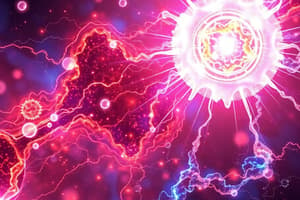Podcast
Questions and Answers
Which of the following statements accurately describe the relationship between the standard cell potential ($E^o_{reaction}$), Gibbs free energy change ($\Delta G^o$), and the equilibrium constant (K)?
Which of the following statements accurately describe the relationship between the standard cell potential ($E^o_{reaction}$), Gibbs free energy change ($\Delta G^o$), and the equilibrium constant (K)?
- A positive $E^o_{reaction}$ corresponds to a negative $\Delta G^o$ and a K < 1, indicating a non-spontaneous reaction at standard conditions.
- A negative $E^o_{reaction}$ corresponds to a negative $\Delta G^o$ and a K < 1, indicating a spontaneous reaction at standard conditions.
- A positive $E^o_{reaction}$ corresponds to a negative $\Delta G^o$ and a K > 1, indicating a spontaneous reaction at standard conditions. (correct)
- A negative $E^o_{reaction}$ corresponds to a positive $\Delta G^o$ and a K > 1, indicating a spontaneous reaction at standard conditions.
The Nernst Equation is used to calculate the cell potential ($E_{reaction}$) exclusively under standard conditions, where all concentrations are 1 mol/L and the temperature is 298 K.
The Nernst Equation is used to calculate the cell potential ($E_{reaction}$) exclusively under standard conditions, where all concentrations are 1 mol/L and the temperature is 298 K.
False (B)
Explain how changes in pH can affect oxidant strength, detailing the chemical principles at play.
Explain how changes in pH can affect oxidant strength, detailing the chemical principles at play.
Changes in pH can significantly affect the oxidant strength in redox reactions, especially those involving $H^+$ ions. As pH decreases (higher $H^+$ concentration), the reduction potential often increases, enhancing the oxidant's ability to accept electrons. This effect is described quantitatively via the Nernst equation, where the hydrogen ion concentration directly influences the reaction's equilibrium and spontaneity.
In biological systems, standard state ($E_o'$) is defined with all species at 1 mol/L EXCEPT $H^+$, which is maintained at a concentration equivalent to pH = ______, which is approximately equal to $1 \times 10^{-7}$ mol/L.
In biological systems, standard state ($E_o'$) is defined with all species at 1 mol/L EXCEPT $H^+$, which is maintained at a concentration equivalent to pH = ______, which is approximately equal to $1 \times 10^{-7}$ mol/L.
Match the components of the Nernst equation to their descriptions
Match the components of the Nernst equation to their descriptions
Which of the following is the correct application of the Nernst Equation to calculate cell potential (E) under non-standard conditions?
Which of the following is the correct application of the Nernst Equation to calculate cell potential (E) under non-standard conditions?
A concentration cell operates based on differences in the standard reduction potentials of the half-cells involved.
A concentration cell operates based on differences in the standard reduction potentials of the half-cells involved.
Describe the process of constructing a balanced redox equation, detailing the steps for balancing atoms and charges.
Describe the process of constructing a balanced redox equation, detailing the steps for balancing atoms and charges.
In the balanced half-reaction for the reduction of $MnO_4^-(aq)$ to $Mn^{2+}(aq)$ in acidic conditions, ______ molecules of water ($H_2O$) are produced as a product.
In the balanced half-reaction for the reduction of $MnO_4^-(aq)$ to $Mn^{2+}(aq)$ in acidic conditions, ______ molecules of water ($H_2O$) are produced as a product.
Match the following terms related to redox reactions with their definitions:
Match the following terms related to redox reactions with their definitions:
Why can't the standard cell potential, $E^o_{reaction}$ be directly used to accurately calculate the equilibrium constant (K) under non-standard conditions?
Why can't the standard cell potential, $E^o_{reaction}$ be directly used to accurately calculate the equilibrium constant (K) under non-standard conditions?
Increasing the concentration of reactants in a redox reaction will always increase the cell potential ($E_{reaction}$), regardless of the reaction quotient (Q).
Increasing the concentration of reactants in a redox reaction will always increase the cell potential ($E_{reaction}$), regardless of the reaction quotient (Q).
Explain how ion-selective electrodes function to measure specific ion concentrations in a solution, detailing the principles behind their selectivity and measurement.
Explain how ion-selective electrodes function to measure specific ion concentrations in a solution, detailing the principles behind their selectivity and measurement.
The cell potential (E) of a concentration cell is ______ when the concentrations in both half-cells are equal.
The cell potential (E) of a concentration cell is ______ when the concentrations in both half-cells are equal.
Match the elements needed to calculate the cell potential associated with the reaction $3Ni^{2+}(aq) + 2Cr(s) \rightarrow 3Ni(s) + 2Cr^{3+}(aq)$
Match the elements needed to calculate the cell potential associated with the reaction $3Ni^{2+}(aq) + 2Cr(s) \rightarrow 3Ni(s) + 2Cr^{3+}(aq)$
In a concentration cell with $Ni^{2+}$ electrodes, if the anode has $[Ni^{2+}] = 1.00 \times 10^{-3} M$ and the cathode has $[Ni^{2+}] = 1.00 M$, which of the following statements is correct regarding electron flow?
In a concentration cell with $Ni^{2+}$ electrodes, if the anode has $[Ni^{2+}] = 1.00 \times 10^{-3} M$ and the cathode has $[Ni^{2+}] = 1.00 M$, which of the following statements is correct regarding electron flow?
In biological concentration cells, the membrane equally facilitates ion transport for all ions, ensuring electrochemical equilibrium is quickly achieved.
In biological concentration cells, the membrane equally facilitates ion transport for all ions, ensuring electrochemical equilibrium is quickly achieved.
Describe how a concentration gradient is utilized to 'do work' in biological systems, giving a specific example.
Describe how a concentration gradient is utilized to 'do work' in biological systems, giving a specific example.
In mitochondria, an H+ ion concentration gradient of approximately ______ pH units is sustained across the membrane, illustrating the potential from ion concentration differences can affect biological process.
In mitochondria, an H+ ion concentration gradient of approximately ______ pH units is sustained across the membrane, illustrating the potential from ion concentration differences can affect biological process.
Match the term to the example it best describes:
Match the term to the example it best describes:
Flashcards
What is 'n' in electrochemistry?
What is 'n' in electrochemistry?
The number of electrons transferred in a reaction.
What is Faraday's Constant (F)?
What is Faraday's Constant (F)?
A constant equal to 96,485 C/mol.
What is a Spontaneous Reaction?
What is a Spontaneous Reaction?
A reaction that proceeds without external energy input.
Gibbs Energy for Non-Standard Conditions
Gibbs Energy for Non-Standard Conditions
Signup and view all the flashcards
What is the Nernst Equation?
What is the Nernst Equation?
Signup and view all the flashcards
What are Standard Conditions?
What are Standard Conditions?
Signup and view all the flashcards
What is a Concentration Cell?
What is a Concentration Cell?
Signup and view all the flashcards
Why use the Nernst Equation for Concentration Cells?
Why use the Nernst Equation for Concentration Cells?
Signup and view all the flashcards
Balancing Redox Equations: Step 1?
Balancing Redox Equations: Step 1?
Signup and view all the flashcards
What are Ion Selective Electrodes?
What are Ion Selective Electrodes?
Signup and view all the flashcards
What is a pH meter?
What is a pH meter?
Signup and view all the flashcards
What is the biological standard state (E°')?
What is the biological standard state (E°')?
Signup and view all the flashcards
pH dependence in redox reactions?
pH dependence in redox reactions?
Signup and view all the flashcards
Finding Unknown Concentrations
Finding Unknown Concentrations
Signup and view all the flashcards
Role of Ion Gradients?
Role of Ion Gradients?
Signup and view all the flashcards
Concentration Cells in Biology
Concentration Cells in Biology
Signup and view all the flashcards
Study Notes
- Module 2, Lecture 8, Part 2 covers electron transfer reactions.
- Chapter 20 of the textbook contains relevant information.
Learning Objectives
- Understand the relationship between E°reaction, ΔrG°, and K.
- Apply the Nernst Equation to find Ereaction and E under non-standard conditions.
- Recognize how oxidant strength is affected by pH.
- Biological standard state E°' is defined.
- Comprehend how electrochemical methods determine concentrations.
- Understand the concept behind concentration cell.
- Learn how concentration gradients result in membrane potentials, and how these potentials can be used to do work.
Predicting Spontaneous Redox Reactions
- Reaction spontaneity is determined by the value of ΔrG°.
- Voltage is a unit of energy, where V = J/C (energy per unit charge).
- ΔrG° = -nFE°reaction, where n is the number of electrons transferred, and F is the Faraday Constant (96485 C/mol).
- ΔrG° relates to K: ΔrG° = -RTlnK.
- E°reaction = (RT/nF) * lnK.
Non-Standard Conditions
- Everything so far has been at standard conditions including 1 mol/L concentrations and 1 bar (approximately 1 atmosphere) pressure.
- Most redox reactions, especially biological ones, occur under non-standard conditions.
- Gibbs Energy under non-standard conditions: ∆rG = ∆rG° + RTlnQ, where Q = [products]/[reactants].
- Equation for calculating E under non-standard conditions: E = E° - (RT/nF) * lnQ (Nernst Equation).
Example Calculation
- Redox reaction between Ni2+(aq) and Cr3+(aq) is considered.
- Ni2+(aq) + 2e- → Ni(s), E° = -0.25 V
- Cr3+(aq) + 3e- → Cr(s), E° = -0.74 V
- Calculating Ereaction when [Ni2+] = 1.0 x 10-4 M and [Cr3+] = 2.0 x 10-3 M can be done using the following steps.
- Ni2+ should be the oxidant in the spontaneous reaction based on the standard reduction potentials.
- Balancing the half-reactions:
- Ni2+(aq) + 2e- → Ni(s) (x3)
- Cr(s) → Cr3+(aq) + 3e- (x2)
- Overall: 3Ni2+(aq) + 2Cr(s) → 3Ni(s) + 2Cr3+(aq), n = 6
- E°reaction = E°(Ni2+/Ni) - E°(Cr3+/Cr) = (-0.25 V) - (-0.74 V) = 0.49 V
- Ereaction = E°reaction - (RT/nF) * ln([Cr3+]2/[Ni2+]3)
- Ereaction = 0.49 V - (8.314 * 298 / (6 * 96485)) * ln((2.0 x 10-3)2 / (1.0 x 10-4)3) = 0.42 V
- K can be calculated from E°reaction.
- Ereaction cannot be used to calculate K.
Balancing Redox Equations
- Reduction potentials commonly involve simple ions, but more complex ions are often dependent on pH.
- Balancing half-equations is necessary.
- Balancing the reduction of MnO4- (aq) to Mn2+ (aq) is shown as an example.
- MnO4-(aq) → Mn2+(aq)
- Balance atoms (Mn is already balanced).
- Balance oxygens by adding water: MnO4-(aq) → Mn2+(aq) + 4H2O(l)
- Balance hydrogens by adding H+: MnO4-(aq) + 8H+ → Mn2+(aq) + 4H2O(l) (H+ is used rather than H3O+).
- Balance charges: MnO4-(aq) + 8H+(aq) + 5e- → Mn2+(aq) + 4H2O(l)
- Total charge is now the same on both sides (+2).
Summary: Balancing Redox Equations
- Balance non-oxygen and non-hydrogen atoms first.
- Balance oxygen atoms by adding water (H2O).
- Balance hydrogen atoms by adding H+ ions.
- Balance charge by adding electrons (e-).
pH-Dependent Reaction Example
- Standard reduction potential for acidic permanganate: E°(MnO4-, H+/Mn2+) = 1.51 V.
- Reaction: MnO4- + 8H+ + 5e- → Mn2+ + 4H2O
- Problem: Find reduction potential when [MnO4-] = [Mn2+] = 1.0 mol/L and pH = 4.0.
- Nernst equation: E(MnO4-, H+/Mn2+) = E°(MnO4-, H+/Mn2+) - (RT/5F) * ln([Mn2+]/([MnO4-][H+]8))
- E = 1.51 V - (8.314 * 298 / (5 * 96485)) * ln(1 / (1.0 x 10-4)8) = 1.13 V
- Oxidizing strength of MnO4- is pH dependent (E = 0.85 V at pH 7).
Biological Standard State (E°')
- All species are at 1 mol/L, EXCEPT H+, which is at 1 x 10-7 mol/L (pH = 7).
- This is a more realistic/relevant biological value.
- Reduction of O2(g) to water at standard pressure and 298 K is considered.
- O2(g) + 4H+ + 4e- → 2H2O, E° = 1.23 V
- At pH = 7: Ereaction = E°reaction - (RT/nF) * lnQ = 1.23 V - (RT/4F) * ln(1/[H+]4)
- E = 1.23 V - (RT/4F) * ln(1/(1 x 10-7)4) = 0.82 V
Finding Unknown Concentrations
- Galvanic cells can determine unknown solution concentrations.
- A galvanic cell with a silver half-cell (standard conditions) and a copper half-cell (unknown [Cu2+]) can be used.
- The sign of Ecell indicates reduction on the RHS, indicating the spontaneous reaction:
- Cu(s) + 2Ag+(aq) → Cu2+(aq) + 2Ag(s)
- Nernst Equation: Ecell = E°cell - (RT/nF) * lnQ = E°cell - (RT/2F) * ln([Cu2+]/[Ag+]2)
- E°cell = E°(Ag+/Ag) - E°(Cu2+/Cu) = 0.80 V - 0.34 V = 0.46 V
- Knowing R, T, F, and [Ag+] = 1.0 mol/L, [Cu2+] can be calculated in this example to be 3.87 x 10-6 mol/L.
Ion Selective Electrodes
- Used to measure concentrations accurately in aqueous solutions.
- A pH meter is an ion-selective electrode that measures [H+] as low as 1 x 10-14 mol/L.
- H+ difference between inside and outside of electrode creates a potential across the glass membrane, proportional to [H+] in the solution sample.
Concentration Cells
- Both cell sides contain the same ions, but at different concentrations.
- Creates electron flow.
- Setup includes Ni anode and cathode with a salt bridge.
Concentration Cells - Spontaneous Reaction
- The sign indicates reduction at the RHS: Ni2+(aq, 1 mol/L) + 2e- → Ni(s)
- Oxidation occurs at the LHS: Ni(s) → Ni2+(aq, 0.001 mol/L) + 2e-
- Spontaneous reaction: Ni2+(aq, 1 mol/L) → Ni2+(aq, 0.001 mol/L)
- Ecell = E°cell - (RT/nF) * ln([Ni2+ 0.001 mol/L]/[Ni2+ 1 mol/L])
- where E°cell = 0 when the electrodes are the same, and n = 2
- Ecell = 0 - (8.314 * 298)/(2 * 96485) * ln((1.00 x 10-3)/1.00) = +0.0888 V
- Ecell is positive for spontaneous reaction.
Membrane Potentials - Biological Concentration Cells
- Concentration cells are crucial in biological systems as well.
- Membranes separate solutions with different ion concentrations.
- Membranes control ion passage, that maintaining concentration gradients.
- Resulting potential difference from concentration gradients can be used to do work.
ATP Synthesis
- In mitochondria, a H+ ion concentration gradient of ~0.5 pH units is maintained.
- Released energy, when H+ ions cross the membrane, is used by ATP synthase to transform ADP and P into ATP.
- [H+] on outside is 5x larger than inside.
Studying That Suits You
Use AI to generate personalized quizzes and flashcards to suit your learning preferences.




